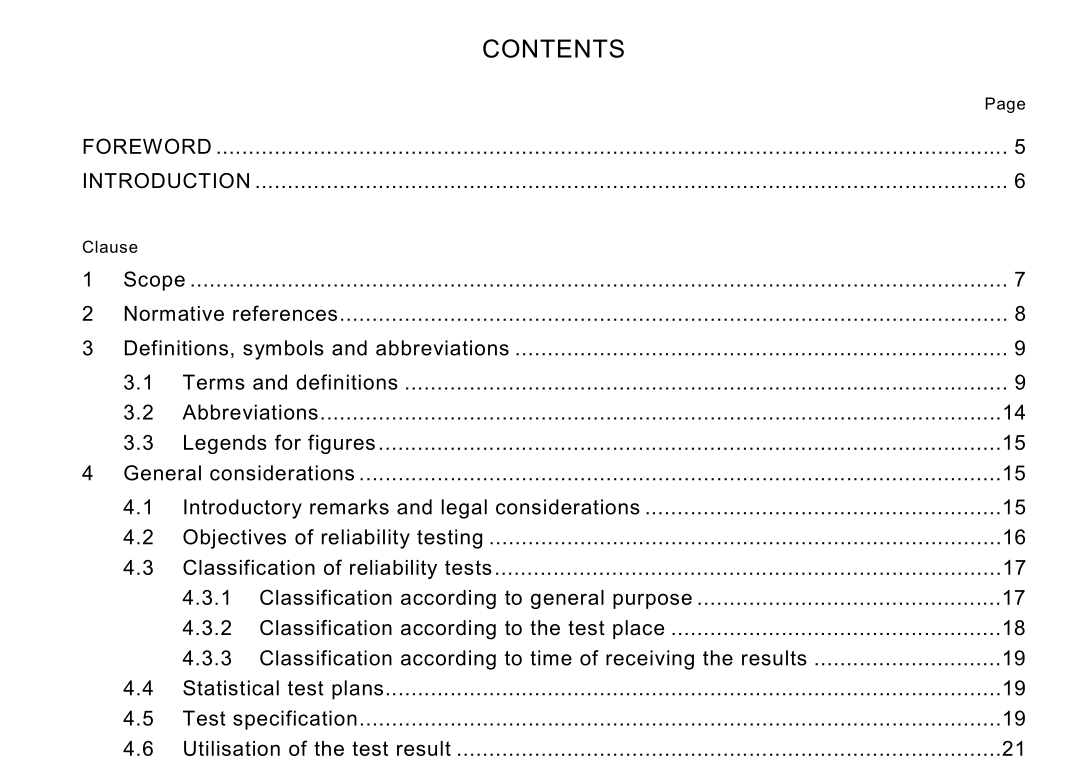BS IEC 60300-3-5 pdf download

BS IEC 60300-3-5 pdf download.Dependability management
1 Scope
This part of IEC 60300 provides guidelines for the planning and performing of reliability tests and the use of statistical methods to analyse test data. It describes the tests related to repaired and non-repaired items together with tests for constant and non-constant failure intensity and constant and non-constant failure rate. It is applicable: – when reliability testing is called for in a contract, either specifically or by inference; – when planning a reliability test; – during a reliability test; – when analysing data from and reporting on the outcome of a reliability test. This standard also applies when a contract or test plan specifies the use of IEC statistical standards, without specific reference to a particular standard. Many different tests are performed during the development, design verification and design validation of a new product. The purpose of these tests is to discover weaknesses in the design and to undertake actions to eliminate these weaknesses and thereby improve performance, quality, safety, robustness, reliability and availability and reduce costs. This standard covers only the cases where statistical methods are used to analyse test data although the guidelines on test conditions, test planning and test documentation will be applicable to most tests.The following topics are important and although discussed in this standard are more fully dealt with in their respective standards: availability testing (see IEC 61 070); testing of maintainability measures (see IEC 60706) and measures of reliability growth (see IEC 61 01 4 and IEC 61 1 64). This standard does not cover software testing (see IEC 61 704), however it is applicable to items containing both hardware and software. This standard is therefore applicable to a wide range of products including consumer, industrial, military and aerospace applications. This part of IEC 60300 covers analysis for verification, determination, comparison and success/failure ratio evaluation. A flow chart giving guidance for planning the statistical treatment of reliability test data is shown in clause 9. Although not described in this standard, the considerations and statistical tools can be used in connection with environmental tests, accelerated step-stress tests and over-stress tests.
3 Definitions, symbols and abbreviations
3.1 Terms and definitions For the purposes of this part of IEC 60300, the terms and definitions given in IEC 60050(1 91 ), some of which are reproduced below, or in ISO 3534-1 , as well as the following definitions, apply. 3.1.1 acceptance test test with the purpose of verifying dependability measures before a design or production lot is accepted by the customer NOTE The customer can be an internal customer or another department of the company or external customer. 3.1.2 censoring termination of the test after either a certain number of failures or a certain time at which there are still items functioning 3.1.3 comparison test test to compare two dependability measures 3.1.4 compliance test test used to show whether or not a characteristic or property of an item complies with the stated reliability requirements [IEV 1 91 -1 4-02, modified] 3.1.5 dependability test test with the purpose of estimating, verifying or comparing dependability measures for items of one or more design and/or production lots NOTE This standard covers reliability tests within dependability testing.3.1.6 determination test test used to establish the value of a characteristic or a property of an item [IEV 1 91 -1 4-03, modified] 3.1.7 discrimination ratio ratio, D, (D > 1 ) characterizing a test plan by its ability to distinguish between an acceptable and an unacceptable dependability measure NOTE The discrimination ratio is a figure of merit for the test plan. 3.1.8 estimation test test used to establish the value of a characteristic or a property of an item [IEV 1 91 -1 4-03, modified] 3.1.9 failure termination of the ability of an item to perform a required function [IEV 1 91 -04-01 , modified] 3.1.1 0 failure criteria set of rules used to decide whether an observed event constitutes a failure 3.1.1 1 (instantaneous) failure rate limit, if this exists, of the ratio of the conditional probability that the instant of time, T, of a failure of an item falls within a given time interval, (t, t + ∆t) and the length of this interval, ∆t, when ∆t tends to zero, given that the item is in an up state at the beginning of the time interval [IEV 1 91 -1 2-02, modified]









